In How To Be we’re going to look at a variety of characters from Not D&D and conceptualise how you might go about making a version of that character in the form of D&D that matters on this blog, D&D 4th Edition. Our guidelines are as follows:
- This is going to be a brief rundown of ways to make a character that ‘feels’ like the source character
- This isn’t meant to be comprehensive or authoritative but as a creative exercise
- While not every character can work immediately out of the box, the aim is to make sure they have a character ‘feel’ as soon as possible
- The character has to have the ‘feeling’ of the character by at least midway through Heroic
When building characters in 4th Edition it’s worth remembering that there are a lot of different ways to do the same basic thing. This isn’t going to be comprehensive, or even particularly fleshed out, and instead give you some places to start when you want to make something.
Another thing to remember is that 4e characters tend to be more about collected interactions of groups of things – it’s not that you get a build with specific rules about what you have to take, and when, and why, like you’re lockpicking your way through a design in the hopes of getting an overlap eventually. Character building is about packages, not programs, and we’ll talk about some packages and reference them going forwards.
You may remember that we’ve looked, earlier in the year, at the character Rock Howard, from Garou: Mark Of The Wolves. Fight games are rich fodder for this kind of exercise because they so often about what a character is and less about what the character does. Simply put, fight games don’t make much sense.
There’s a scale at work, of course. Some games make more sense, with a deliberate intention to ground the storytelling in something serious. Some games, on other hand, are pretty silly, and don’t really care about how silly they get.
Anyway, Guilty Gear.
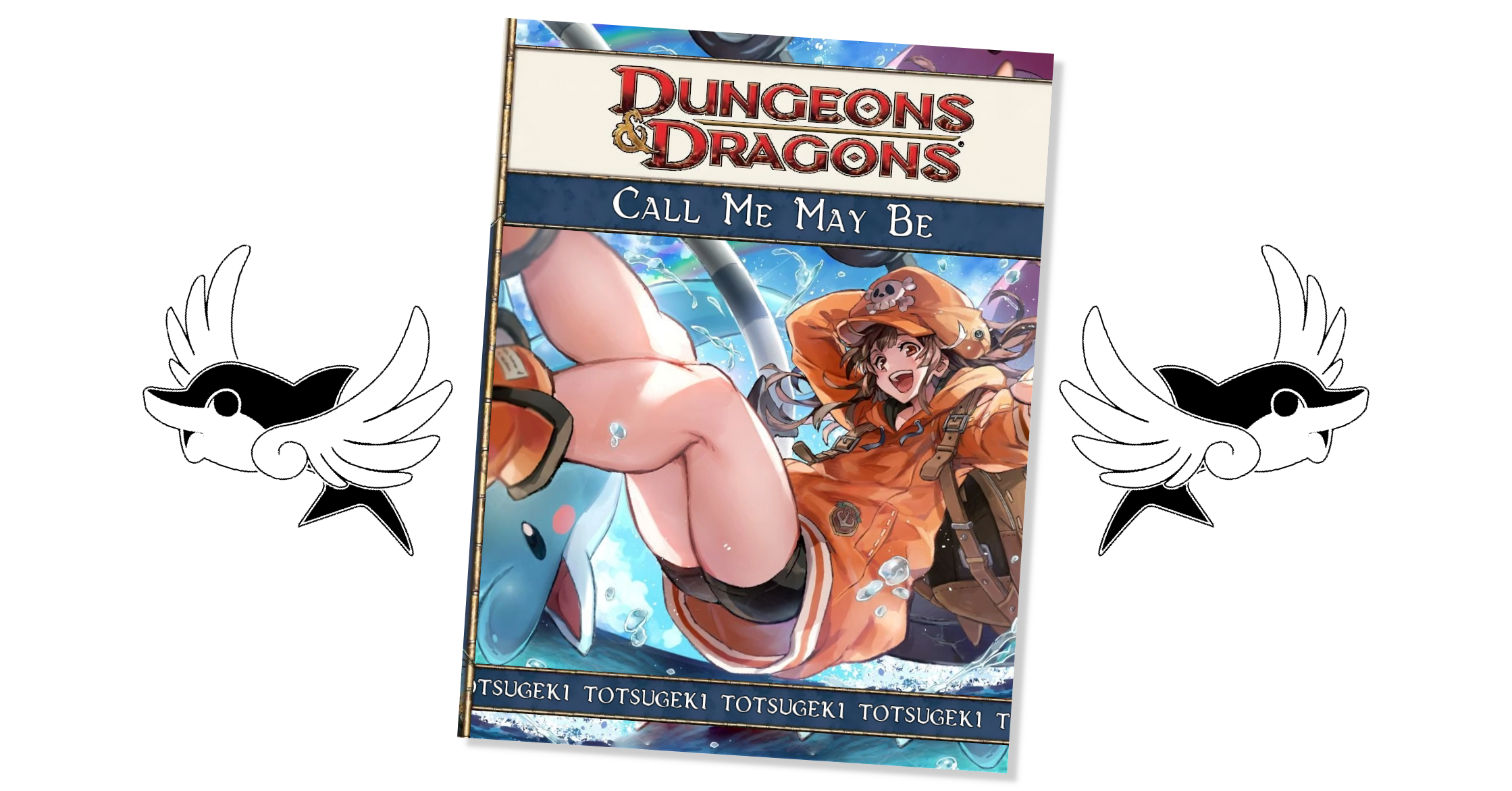
Examining May
This one is going to be fun, and it’s going to be fun because I don’t know anything about May. I mean, I don’t know about every character I cover — this whole feature started looking at a Fire Emblem character and I still don’t know anything about that franchise, really. But it’s also going to be fun because there are three different ways to treat a character from a fight game, and I want to look at all of them.
There’s what a character does.
There’s how a character feels.
And there’s how a character plays.
May is a petite bruiser who hangs with a crew of sky pirates. She’s from a ridiculous superpower universe where the eventual reveal, spoilers for the nonsense land of Guilty Gear, is that her ability to wield an enormous axe is because she’s Japanese, a culture of people who have been almost-exterminated by… I want to say haunted bears? That’s why she’s an orphan, she had to be smuggled out of the state-sized concentration camp/zoo thing for the preservation of Japanese culture. I think? Look, things are weird in Guilty Gear.
Anyway, she’s fun and peppy and she’s got a ridiculously positive attitude, kinda boy crazy for dudes older than her which okay not comfortable but whatever and she’s aggressively violent in her opposition to bald men. Again, things are weird.
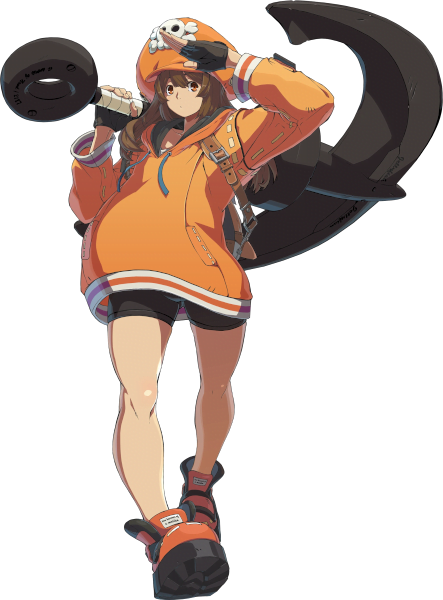
She doesn’t wear heavy armour as normally depicted, but she does cover her body up with layers of fabric, and oh, hey, we also have a weapon option. She’s got a weapon. Check it out. It’s that great big bloody anchor, which she uses to reach people a distance and hit them. You may think ‘well if she can do that, she must be really strong’ and the answer is yes, characters remark on how strong May is. That could be generic fight game language (‘ah, you’re so strong, person who defeated me’) but it sure seems to just mean lifting power when you’re lugging around an anchor for stopping a skyboat.
That’s a broad analysis of just looking at her, and getting an idea of some real basic stuff, but hey, let’s not forget something that anyone who’s played the game is thinking:
She has a pet teleporting dolphin that she uses to hit people.
That’s her as she exists, like, in her universe, in her narrative. That’s not all there is to May though. The thing is, May is a game object from another game, and that game has wholly different rules. The lore of the character, like the diegesis may tell us she’s strong and uses an anchor, but as a game object, she’s absolutely known for her ability to hit you with the dolphin a lot, which moves her forwards and limits your options. In Guilty Gear there’s a way of looking at the game state as being positive, neutral, or negative — and I know I’m immensely simplifying. Positive is when you’re getting an advantage by what you do, negative is when you are put on the defensive by what you do, and neutral is when you end your opponent end up on equal footing. Literally just quoting my friend who explained this to me.
In that time, when nothing else is going on, May just takes charge.
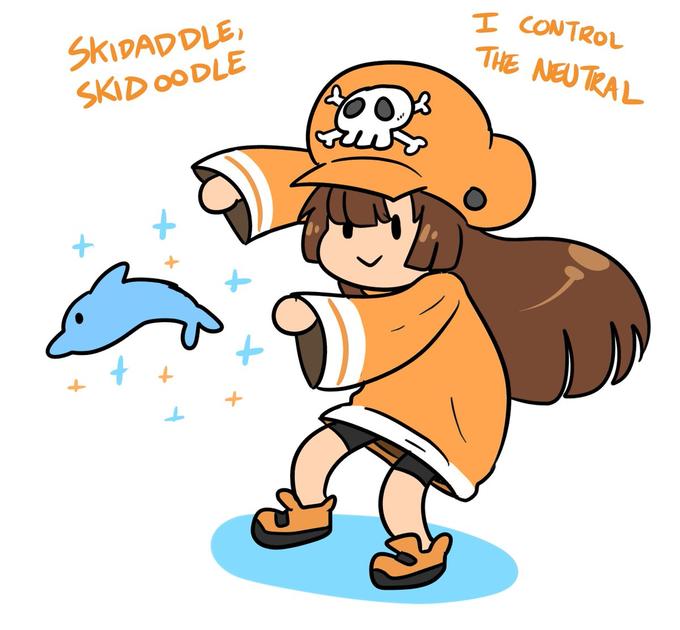
There’s no strong pull towards a particular type of damage in May’s powers, we can set that out.
She’s also kind of inherently proactive, but that’s something you can point to with most characters in a fighting game. Well, there are characters built around counters and grappling, but broadly, the typical fighting game character wants to make the opponent fall down for good and that inevitably involves a plan that you have to enact. Because fight game characters are also typically solitary and lack recovery/healing opportunities, it doesn’t seem very likely that she fits into any of the leader roles.
Another detail to consider is control. Now David Sirlin (sigh) would ruminate on how all fighting games are ‘about control’ — about whether you’re forcing the opponent to respond to your actions or if they are forcing you to respond to them. The same is true in Magic: The Gathering. You are trying to exert control over your opponent, making them react to you. In 4ed D&D though, a group and cooperative environment, control is much more about action economy. If you can reduce an opponent’s actions, through your actions, you are establishing control. The best and easiest example is a hypothetical move that, if you hit the enemy with it, they’re dazed — you trade one of your actions for two of your opponent’s.
This is where we get this contention; do we want to represent control in her game (where it looks like applying pressure to one target) or in D&D (where it can often look like spreading your actions around)? We’ll look at both options.
Essentials
So about that dolphin.
I kid you not, the dolphin is one of the easy bits.
Look, D&D is full of magical creatures. You can absolutely, very easily, get a pet that follows you around and tell your DM ‘hey, I know the rules say this is a <this> but it looks like <that>.’ That’s going to be the theme, too, which is great because themes are often a blank spot in most builds unless you’re like me going werebear-silly. This time, we’re talking about the Fey Beast Tamer.
The Fey Beast Tamer gives you a pet, which has an aura around it. If you’re in the aura, you get an advantage. What I’d recommend for May is a Blink Dog, which lets you teleport anywhere within the aura. If you’re greedy for damage, the Baby Owlbear improves your damage with an untyped buff. This pet can be used for a few oddball effects, but the big three things to know:
- Whenever you make a move action you can move the pet too
- Whenever an enemy provokes an attack of opportunity from the pet, it can take it
- You can’t attack with the pet without using your actions to do it, and that will usually not be worth it.
This means the optimal strategy with the Fey Beast Tamer is usually to move into position fighting an enemy, move your pet to be next to you or the opponent in a way that inconveniences them, then make your attacks. There are some cute tricks you can do with this, and we’ll talk about that more in the other entries, but don’t think of the pet as ‘giving you an extra attack’ as much as ‘giving you an extra square in the battlefield you control.’
Now this is important: May in Guilty Gear presents more than one type of sea life as her attack buddy (though they all can fly?) and you can go that route with a lot of summons, but it’s much easier and simpler to pick a single pet and stick with it. Besides, you get to hang around and talk to your flying dolphin buddy, or even unsummon them if you like to look like you don’t hang with a floating Mr Dolphin.
May also needs a huge bloody weapon. Lots of options there and they’ll vary by type, but the default I like is an execution axe. It’s big, it has the right kinda curve. There are other options that come up, and you may just want to stick with weapons like the Halberd and Maul if you don’t want to spend a feat getting a Superior weapon.
Also, May’s almost certainly a high-strength character, and by all accounts of her personality I can find, she’s a dumbass, meaning you’re not going to be getting a lot of high-intelligence, book-learny type designs.
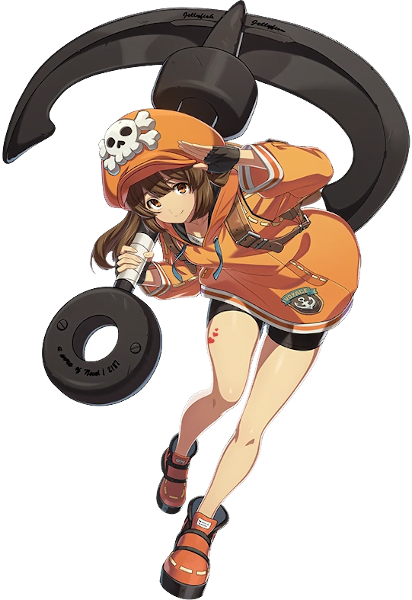
How She Plays: The Violent Rush
Strength based striker with some form of control, ey? Well, looks to me like the simplest solution here is the Barbarian. Now, we don’t necessarily have a lot of information that indicates May is prone towards wilderness survival or uh, flights of rage, except the way that she reacts to meeting a bald guy.
Start with barbarian, and focus on charge optimisation. Feats like Powerful Charge and Two-handed Weapon Expertise, and and the old classic Horned Helm. This is especially important for carrying out the play pattern of May in Guilty Gear. What you can do is use your Blink Dolphin style pet to create a situation where you get to charge, and charge, and charge, and charge.
Okay, look, let’s bust out the diagrams. This is the simplest technique:
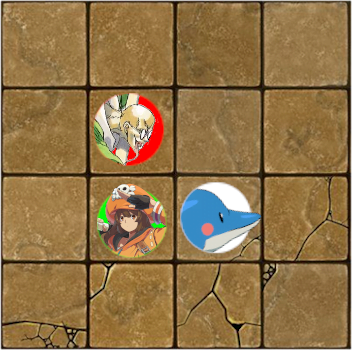
First, when you engage with an enemy, you want a situation like this. Note that you don’t need all these squares of movement, this is just the simplest version. The circle up to the top is your opponent, and then there’s you as May and Dolphin next to it and the enemy. You want the dolphin there because if the enemy decides to leave, you can get an attack of opportunity on them.
On your turn, you can use your move action to teleport anywhere adjacent to your Dolphin, so you go here:
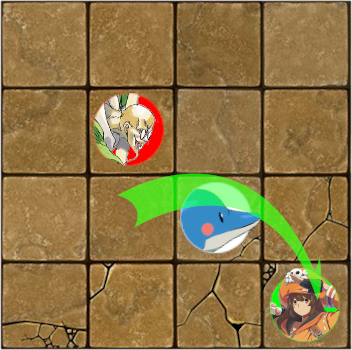
And then, because of how charging works in 4th edition, you have to squares you can move into that let you always move closer to your enemy – which means you can charge them around your dolphin friend like this.
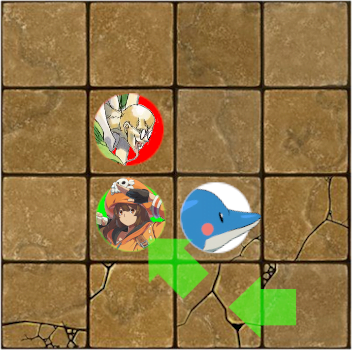
This is a rinse-and-repeat situation. You moved safely out of range and then you got to charge right back in, meaning you can smash enemies with all those juicy ‘do stuff on a charge’ options. You will always have an option when you want to pick up powers that Do Things on a Charge, and this gives you a reliable way to smash into your opponent from a distance, but also you can treat your charge as no longer a sometimes food.
Do you get it.
She gets to do this over and over again.
Charging opponents with your dolphin.
How She Feels: Big Reach Bruiser
In her story space, May is someone who has a big weapon and is off doing wild adventures to advance the aims of her friends working in a flying pirate ship. This is a chance to work with that character who’s a sort of defender and protector of her friends, while also relying on a great big hecking weapon. She’s also got ‘special powers’ – and so, we get the Battlemind.
Battlemind gives you psychic powers, and it also gives you the ability to push people into corners and knock them down with powers like Bull’s Strength. This build is one I’ve gone over to some extent, and really blossoms in Paragon, but in heroic still works just fine. First, you just operate as a Battlemind. You’ll want Lightning Rush at level 7 for that good good teleport-charging. I recommend you pick up Bull’s Strength, too, and then try to optimise your pushes with things like Rushing Cleats. Finally, as you hit your basic requirements and get more magic equipment, multiclass fighter and take Polearm Momentum, and suddenly you’re throwing whole groups to the ground in a blast.
What She Does: Return To Dolphin
Not every build needs to be ridiculous or complicated. May is renowned for not being complicated — the archetype she’s meant to be is is commonly called a ‘gorilla,’ with the idea that doing the same thing enough means eventually your opponent will mess up and you’re going to get an advantage.
Therefore, the simplest possible May build, with our default of the Fey Beast Tamer and the Execution axe is to just take Fighter. That’s it. You can layer on other malarkey if you want – and if you’re planning on expanding the build, you could go Halberd and play around with the fighter’s Polearm malarkey we discussed in the Daryun article.
This build gets you most of what you want right up front: a strong character with a pet dolphin who tries to do the same thing every turn and punish opponents who mess up.
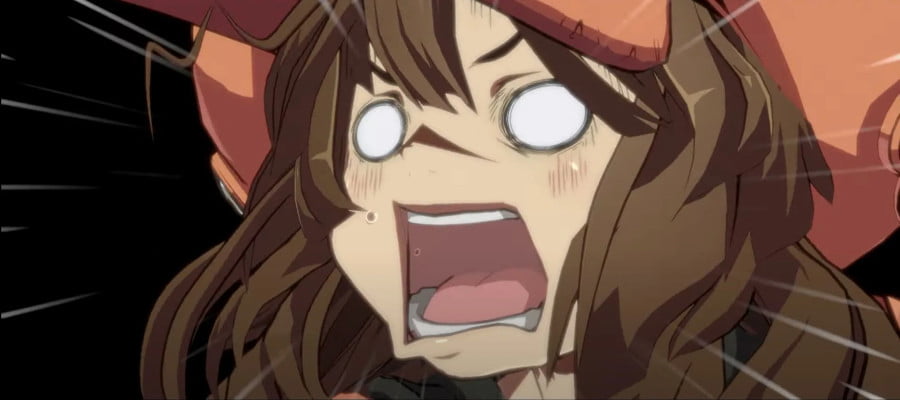
Junk Drawer
What’s some other fun stuff you could do? Well, if you want to make May into a melee damage dealer and leader, the bard counts. That’s important, because her music is, as it goes, a banger, which is great. Always good to have that going on. There’s also stuff you can do with heavy charge based builds that use the Eladrin and Swordmage and Swordmage advance that definitely lets you play like the teleport-focused Corvo build from back in the day, but the problem there is that uh, the Swordmage’s most important stat is intelligence, and uh
Nope!
You can also structure a type of May that relies on spirit sharks using the power of the Shaman or the Psion, but neither of them really feel like May’s bruiser type.
This one was a lot of fun. I got to watch a lot of videos of how May fought, I learned a bunch of memes, and I learned about something that matters a lot to a friend. And I got to talk about how you can have a pet teleporting dolphin!
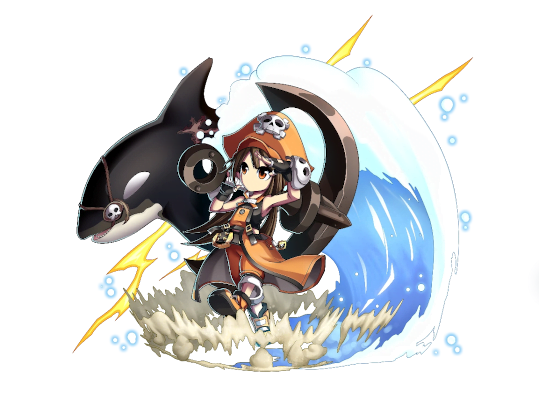
2 Trackbacks